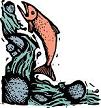|
 River Raiders River Raiders
This lesson plan introduces elementary school participants to stream ecology, salmon and their habitat, and human impact on rivers using hands-on, role-play, and art activities that draw upon the intelligences of various learning styles of students.
Download pdf

Yes P.L.E.A.S.E. Trees
This activity teaches participants about riparian habitats of the Willamette River using plant and animal identification cards, and a metaphor exercise. A focus on riparian plant life demonstrates to students that stream habitat is dependent on the terrestrial life that it flows through.
Download pdf
 Splash in the Willamette Splash in the Willamette
This activity introduces participants to recreational uses of the Willamette River, as well as a history of recreational fishing and boating on the Willamette River using simulator activities and mathematics. It involves a strong focus on human-river interactions, demonstrating how our actions have an impact on natural habitat, and how one can enjoy aquatic recreation while limiting negative environmental effects.
placeholdplaceholdDownload pdf
 Erosion Loco Motion Erosion Loco Motion
This activity introduces participants to the importance of sediment in riparian areas by discussing the processes, types, and impacts of erosion. Using the stream simulator students can witness the effects of fluvial erosion first-hand, through natural rivers, human induced structures such as culverts, as well as a demonstration of a dam collapse.
placeholdplaceholdDownload pdf

Diatomination
This activity introduces participants to diatoms and their impact on river/stream ecology. It teaches which environments around the river diatoms will be located. This lesson plan builds off previous knowledge of primary energy production, tropic levels, and microscope use. The activities show how even the biggest of life forms are dependent on microscopic organisms for their survival.
placeholdplaceholdplacDownload pdf
|

